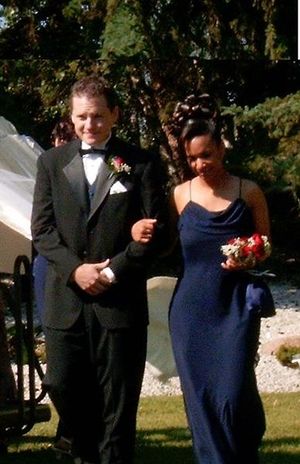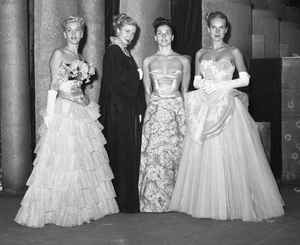Evening gown: Difference between revisions
m (Text replacement - " satin" to " satin") |
m (Text replacement - "flapper" to "flapper") |
||
| Line 13: | Line 13: | ||
As centuries rolled by, most gowns were generally very elaborate, but more so for formal occasions. In the [[18th century]], formal dress started as the mantua, but later developed into the elaborate sack-back gown. | As centuries rolled by, most gowns were generally very elaborate, but more so for formal occasions. In the [[18th century]], formal dress started as the mantua, but later developed into the elaborate sack-back gown. | ||
Starting with the 19th century, the term "evening gown" began. The fashinable length was ankle-length, but, during the reign of Victoria, the evening gown became floor-length. The styles ranged from having huge sleeves in the 1830s, to off-the-shoulder and with wide flounces in the 1840s, to very low-necked in the 1850s, to having low necklines and short sleeves in the 1860s, to long and lean with a bustle and very short sleeves in the 1870s, to sleeveless, low-necked, and worn with gloves in the 1880s, to having a squared decolletage, a wasp-waist cut, and skirts with long trains in the 1890s. | Starting with the 19th century, the term "evening gown" began. The fashinable length was ankle-length, but, during the reign of Victoria, the evening gown became floor-length. The styles ranged from having huge sleeves in the 1830s, to off-the-shoulder and with wide flounces in the 1840s, to very low-necked in the 1850s, to having low necklines and short sleeves in the 1860s, to long and lean with a bustle and very short sleeves in the 1870s, to sleeveless, low-necked, and worn with gloves in the 1880s, to having a squared decolletage, a wasp-waist cut, and skirts with long trains in the 1890s. | ||
During the Edwardian era, the empire silhouette was popular. Later, in the 1920s, evening gowns were very simple to match the style of the flapper era. Starting with the 1930s, evening gowns began to modernize. Along with the empire cut, over the years the sheath, mermaid, A-line, and trumpet shapes became popular. Also, the dropped waist and princesse styles were frequent, depending on the era. Movie star '''Grace Kelly''' is noted for wearing understated evening gowns. | During the Edwardian era, the empire silhouette was popular. Later, in the 1920s, evening gowns were very simple to match the style of the [[flapper]] era. Starting with the 1930s, evening gowns began to modernize. Along with the empire cut, over the years the sheath, mermaid, A-line, and trumpet shapes became popular. Also, the dropped waist and princesse styles were frequent, depending on the era. Movie star '''Grace Kelly''' is noted for wearing understated evening gowns. | ||
Today, the evening gown comes in any silhouette, and is popular for occasions such as a state dinner or evening party. | Today, the evening gown comes in any silhouette, and is popular for occasions such as a state dinner or evening party. | ||
Latest revision as of 07:00, 14 April 2024


An evening gown is a long flowing women's dress usually worn to a formal affair. It is generally floor-sweeping. Evening gowns are often made of an elegant fabric such as chiffon, velvet, satin, taffeta, silk, or charmeuse. ]]. Although the terms are used interchangeably, ball gowns and evening gowns differ in that a ball gown will always have a full, flared skirt and a strapless bodice; in contrast, an evening gown can be any silhouette - sheath, mermaid, A-line or trumpet shaped - and may have straps, halters or even sleeves.
It corresponds to men's semi-formal wear for black tie events. (For white tie equivalents, and for debutantes, see Ball gown.)
- For a brief history of the gown, see Clothing terminology.
History
In the Middle Ages, formal dress for women had yet to be developed. Women simply added a train to their kirtle for formal occasions. As centuries rolled by, most gowns were generally very elaborate, but more so for formal occasions. In the 18th century, formal dress started as the mantua, but later developed into the elaborate sack-back gown. Starting with the 19th century, the term "evening gown" began. The fashinable length was ankle-length, but, during the reign of Victoria, the evening gown became floor-length. The styles ranged from having huge sleeves in the 1830s, to off-the-shoulder and with wide flounces in the 1840s, to very low-necked in the 1850s, to having low necklines and short sleeves in the 1860s, to long and lean with a bustle and very short sleeves in the 1870s, to sleeveless, low-necked, and worn with gloves in the 1880s, to having a squared decolletage, a wasp-waist cut, and skirts with long trains in the 1890s. During the Edwardian era, the empire silhouette was popular. Later, in the 1920s, evening gowns were very simple to match the style of the flapper era. Starting with the 1930s, evening gowns began to modernize. Along with the empire cut, over the years the sheath, mermaid, A-line, and trumpet shapes became popular. Also, the dropped waist and princesse styles were frequent, depending on the era. Movie star Grace Kelly is noted for wearing understated evening gowns. Today, the evening gown comes in any silhouette, and is popular for occasions such as a state dinner or evening party.
White tie occasions
When worn to white tie occasions, the evening gown is generally more elaborate than when worn to black tie occasions. For example, the silhouette will be fuller, to match with the "very formal" white tie attire by men. In the modern times, the evening gown is becoming more frequent in women's formal wear, even at white tie occasions. However, etiquette states that a ball gown must be worn.
Black tie occasions
Evening gowns can range to tea length (mid-calf to ankle-length) to full-length (to the floor). In general, the same rules of a white tie event apply to a black tie event, although in some cases a cocktail dress is acceptable. However, women usually wear evening gowns to black tie occasions.
Different Styles Of The Evening Gown
Sheath
A sheath style evening gown, like the usual sheath dress, is designed to fit the body tightly. It is generally unbelted, and has a straight drape. It can have shoulder straps or be strapless.
Mermaid
Mermaid, as the name suggests, means that the evening gown is shaped like a mermaid. It is form-fitting at the bodice, and the skirt is designed to resemble a mermaid's tail in silhouette.
A-line
The A-line silhouette is somewhat bell-shaped, it is close-fitting at the top and widens gradually at the bottom, without gathers or pleats. This makes the evening gown simple but elegant.
Trumpet
If the evening gown is trumpet shaped, it is tight-fitting until it reaches the knees, where it flares.
Empire
The Empire silhouette involves the waistline coming up to just below the bust, from which the skirt hangs straight and loose, in a simple breezy style.
Dropped Waist
The waistline of the evening gown is dropped below the actual waistline. The skirt can be fitted or flared.
Princesse
A princesse style evening gown is also tight, cut in single pieces, such as gores, and hanging in an unbroken line from shoulder to flared hem.
Alternatives to the gown
- In the 1940s, couturiers introduced dancing costumes, a party dress with a full skirt specifically made for semi-formal and formal dances. The dancing costume was shorter than the evening gown.
- A ball skirt is a variant fashion which resurfaced in the 1990s, consisting of a full, long skirt that can be worn with a cashmere sweater, lace camisole, or other dressy top.
See also
| Articles about Formal attire |
|---|
| Articles about Gowns |
|---|
| Portal:Clothing articles |
|---|
|